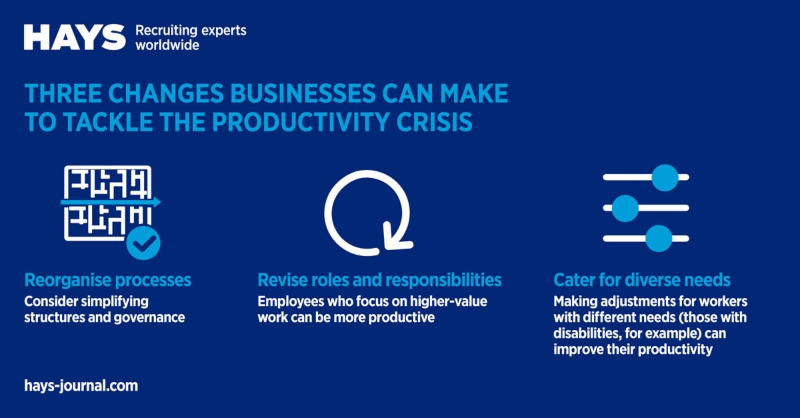Professionals are overworked by productivity pressures – but there’s another way

Pressure on productivity has seen many businesses try to squeeze more output per hour – but according to recruiting experts Hays, now is the time to explore other approaches.
The Hays Journal reported recently that Deloitte analysis of International Labour Organization data shows productivity growth failed to beat the 3.9 per cent peak it reached in 2006, before falling off sharply after the 2008 financial crisis.
Organisations value productivity because it’s one of the two main drivers of business and economic growth – the other being increases in the number of people working. But, according to Hays, many organisations are starting to question the current ways of measuring productivity.
“Rather than trying to squeeze more out of their existing employees, businesses and policymakers should refocus their attention on a broader range of drivers to get a more balanced picture of productivity performance and have a better chance of improving it,” said Tom Osborne, Managing Director of Hays Malaysia.
According to the Hays Journal, the focus could instead be on:
• Customer service: Global learning company Pearson has seen its productivity levels improve since the business moved away from the traditional focus of output per hour to the quality of customer service.
Kevin Lyons, its Senior HR Manager in London, told Hays: “Measuring yourself against quality of customer service keeps you nimble, reviewing your processes and looking at your culture and, therefore, you’re less likely to lapse into lower productivity.”
• Reorganising processes: Pharmaceutical giant Pfizer has simplified processes, structures and governance to create a more productive organisation that empowers colleagues and drives faster decision-making.
Meetings and emails emerged as processes that took up time and drained productivity. A team of volunteers was engaged to come up with practical and quickly implementable solutions. According to Yulia Novoderezhkina, HR Business Partner of Pfizer in Russia, this involvement of staff was key. “This boosts the level of engagement as we feel that we are all part of the process. The changes have helped to free up capacity for growth and liberate our time to focus on what really matters – delivering value to patients and people who need us.”
• Revising roles and responsibilities: Research from Bain & Company reveals the best companies are more than 25 per cent more productive than the rest, thanks to the way they manage their best talent, including the roles and responsibilities they assign to them.
This involves identifying and tracking the progress of star talent, assembling all-star teams and putting them to work on mission-critical initiatives, removing obstacles to the team working effectively together, and controlling team member egos.
• Identifying workforce needs: Looking beyond organisational roles and responsibilities to the personal needs of employees can also help to boost productivity.
Juliet Turnbull is Founder and CEO of 2to3days, a start-up whose purpose is to advance women’s equality in the workplace through the power of flexible working. She says that companies that are willing to adapt to accommodate flexible workers – through, for example, a change in working hours or the provision of technology to accommodate remote working – are much more likely to have happy workers who are more productive and loyal. This, in turn, pushes down recruitment costs, immediately impacting on the cost side of the productivity calculation.
• Technology boost: In its 2017 report – A future that works: automation, employment and productivity – the McKinsey Global Institute highlights automation as a way of offsetting the impact of a declining share of working age population. According to its scenario modelling, automation could raise productivity levels by 0.8 to 1.4 per cent annually.
This issue is explored further in the latest Hays Journal.
Last updated on January 28th, 2020
Hays Research
DNA Series
Uncovering the DNA of the Future Workplace

